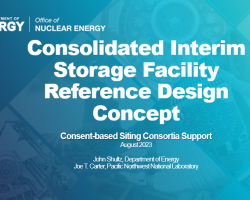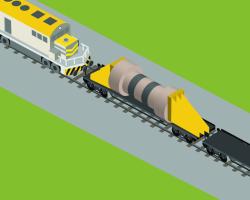Category of Content
Siting Experience Documents Only
Publication Date
Subject Matter
Keywords
Preliminary Evaluation of Removing Used Nuclear Fuel from Shutdown Sites
Preliminary Evaluation of Removing Used Nuclear Fuel from Shutdown Sites
Appendix A – Design Changes Due to the Addition of the HI-STAR 190 Casks
Appendix A – Design Changes Due to the Addition of the HI-STAR 190 Casks
M3SF-21PN020401053- COBRA-SFS Version 6.1 User Guide- A Thermal Hydraulic Analysis Code for Spent Fuel Storage and Transpor
M3SF-21PN020401053- COBRA-SFS Version 6.1 User Guide- A Thermal Hydraulic Analysis Code for Spent Fuel Storage and Transpor
M4SF-19ID020303045- Atlas Railcar Phase 3 Final Report
M4SF-19ID020303045- Atlas Railcar Phase 3 Final Report
Performance Specification for Standardized Transportation, Aging, and Disposal Canister Systems
Performance Specification for Standardized Transportation, Aging, and Disposal Canister Systems
Appendix B – Revised Railcar-to-Cradle Attachment Interface
Appendix B – Revised Railcar-to-Cradle Attachment Interface
Development of Consolidated Storage Facility Design Concepts
Development of Consolidated Storage Facility Design Concepts
Appendix D – Revised Conceptual Cradle Design Family 4
Appendix D – Revised Conceptual Cradle Design Family 4
Standardized Transportation, Aging, and Disposal Canister Feasibility Study
Standardized Transportation, Aging, and Disposal Canister Feasibility Study
Nuclear Fuels Storage and Transportation Requirements Document
Nuclear Fuels Storage and Transportation Requirements Document
Task Order 18 Updated Final Report: Generic Design for Small Standardized Transportation, Aging and Disposal Canister Systems UPDATED FINAL REPORT
Task Order 18 Updated Final Report: Generic Design for Small Standardized Transportation, Aging and Disposal Canister Systems UPDATED FINAL REPORT
Dry Storage Cask Inventory Assessment
Dry Storage Cask Inventory Assessment
Preliminary Used Nuclear Fuel Storage Design Concept
Preliminary Used Nuclear Fuel Storage Design Concept
Summary of Design Criteria for Dry Cask Storage Systems for ISFSI Storage of Shutdown Reactor Spent Nuclear Fuel?
Summary of Design Criteria for Dry Cask Storage Systems for ISFSI Storage of Shutdown Reactor Spent Nuclear Fuel?
Generic Design Alternatives for Dry Storage of Spent Nuclear Fuel
Generic Design Alternatives for Dry Storage of Spent Nuclear Fuel
Generic Design Alternatives for Dry Storage of Spent Nuclear Fuel
Generic Design Alternatives for Dry Storage of Spent Nuclear Fuel
Public Preferences Related to Consent-Based Siting of Radioactive Waste Management Facilities for Storage and Disposal: Analyzing Variations over Time, Events, and Program Designs
Public Preferences Related to Consent-Based Siting of Radioactive Waste Management Facilities for Storage and Disposal: Analyzing Variations over Time, Events, and Program Designs
The Social and Ethical Aspects of Nuclear Waste
The Social and Ethical Aspects of Nuclear Waste
Nuclear waste management seems to exist in a perpetual state of crises. For 50 years the nuclear states of the world have fought, and generally lost, the battle to deal with the nuclear waste problem. Worldwide, there is a growing acknowledgement within industry and government that social and ethical issues are just as important as technical issues when developing safe programs for nuclear waste management. This paper is a review of some of the outstanding social and ethical issues that are influencing discussions on nuclear waste management around the world.
Monitored Retrievable Storage Facility Design Criteria Policy Document - 2nd Draft
Monitored Retrievable Storage Facility Design Criteria Policy Document - 2nd Draft
Survey of National Programs for Managing High-Level Radioactive Waste and Spent Nuclear Fuel: 2022 Update
Survey of National Programs for Managing High-Level Radioactive Waste and Spent Nuclear Fuel: 2022 Update
In October 2009, the U.S. Nuclear Waste Technical Review Board (Board or NWTRB) published Survey of National Programs for Managing High-Level Radioactive Waste and Spent Nuclear Fuel. For each of the 13 national programs studied, the report catalogued 15 institutional arrangements that had been set in place and 15 technical approaches that had been taken to design repository systems for the long-term management of high-activity radioactive waste.
Going the Distance? The Safe Transport of Spent Nuclear Fuel and High-Level Radioactive Waste in the United States - Summary
Going the Distance? The Safe Transport of Spent Nuclear Fuel and High-Level Radioactive Waste in the United States - Summary
This new report from the National Research Council’s Nuclear and Radiation Studies Board (NRSB) and the Transportation Research Board reviews the risks and technical and societal concerns for the transport of spent nuclear fuel and high-level radioactive waste in the United States. Shipments are expected to increase as the U.S. Department of Energy opens a repository for spent fuel and high-level waste at Yucca Mountain, and the commercial nuclear industry considers constructing a facility in Utah for temporary storage of spent fuel from some of its nuclear waste plants.
Consolidated Interim Storage Facility Reference Design Concept
Consolidated Interim Storage Facility Reference Design Concept
Presentation slides on the Consolidated Interim Storage Facility Reference Design Concept, including site plans; handling, inspection and repackaging concepts and facilities; and cost and staffing estimates.
Summary of Consolidated Interim Storage Advantages and Disadvantages from an Integrated Systems Perspective from Prior Reports and Studies
Summary of Consolidated Interim Storage Advantages and Disadvantages from an Integrated Systems Perspective from Prior Reports and Studies
The question of whether centralized storage of civilian spent nuclear fuel (SNF) should be part of the federal waste management system as an intermediate step before permanent disposal has been debated for more than four decades. Centralized storage facilities were included as a potential component of the U.S. spent fuel management system in the Nuclear Waste Policy Act of 1982 (NWPA), but the NWPA did not identify these facilities as being essential.
Transportation Institutional Issues Involving the U.S. Department of Energy's Civilian Radioactive Waste Management Program: The Post Yucca Mountain Years
Transportation Institutional Issues Involving the U.S. Department of Energy's Civilian Radioactive Waste Management Program: The Post Yucca Mountain Years
This 10th anniversary update to the original archive adds several sections that cover relevant topics since 2010. Some of the new topics include the Blue Ribbon Commission on America's Nuclear Future, consent-based siting, tribal engagement, shutdown site visits, and industry interests. Much like the first publication, the purpose of this update is to make it easier for new personnel to learn about what came before them in the hope that this knowledge gives them a greater chance of success.




